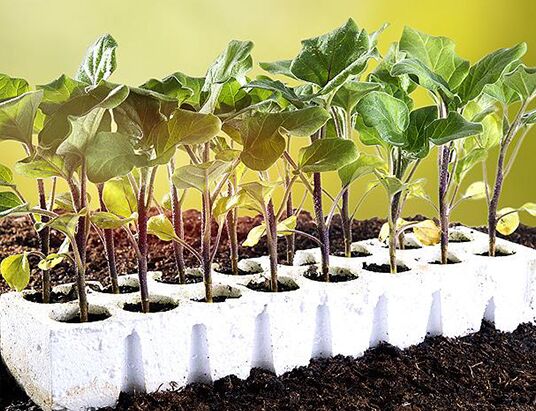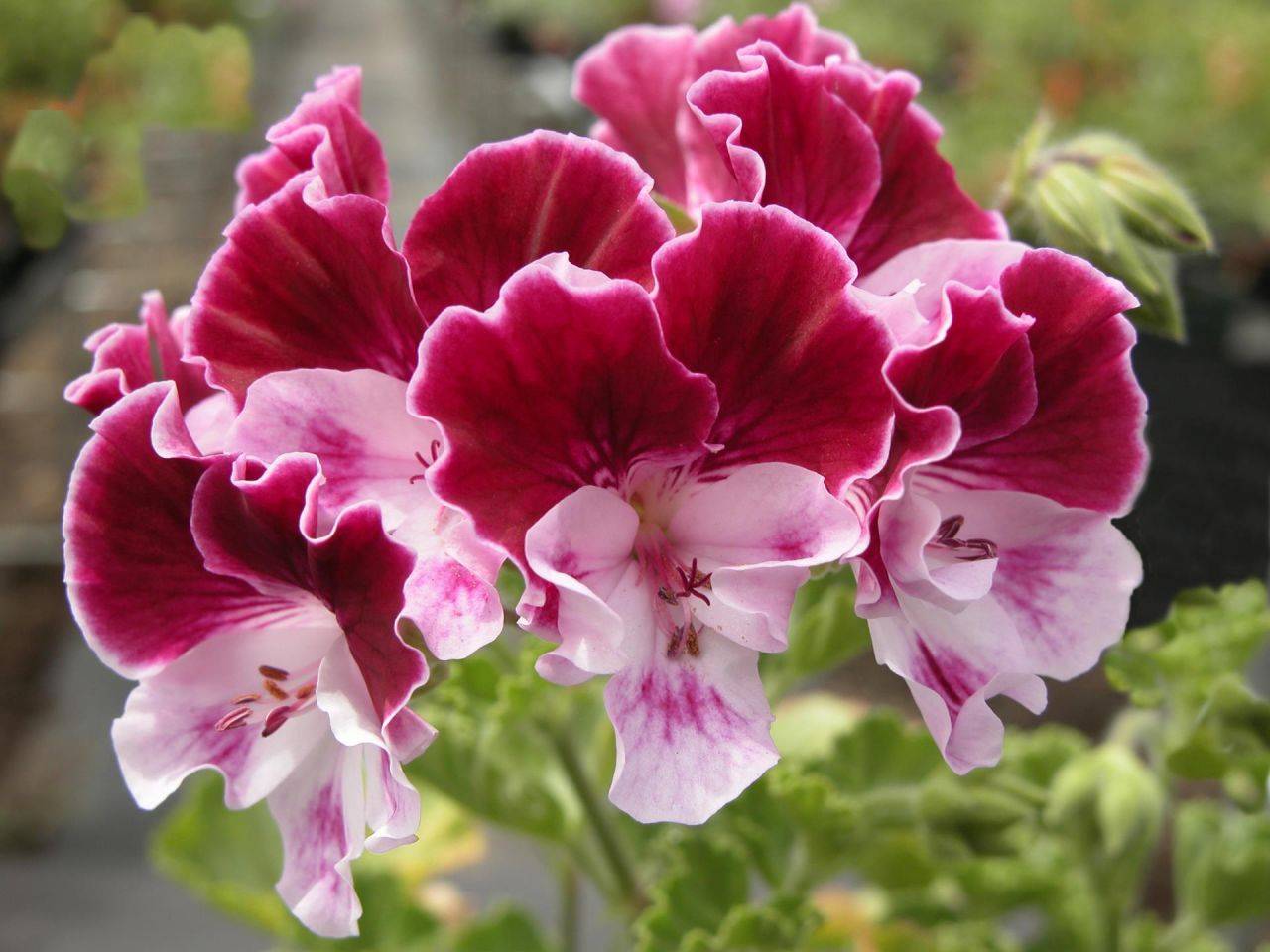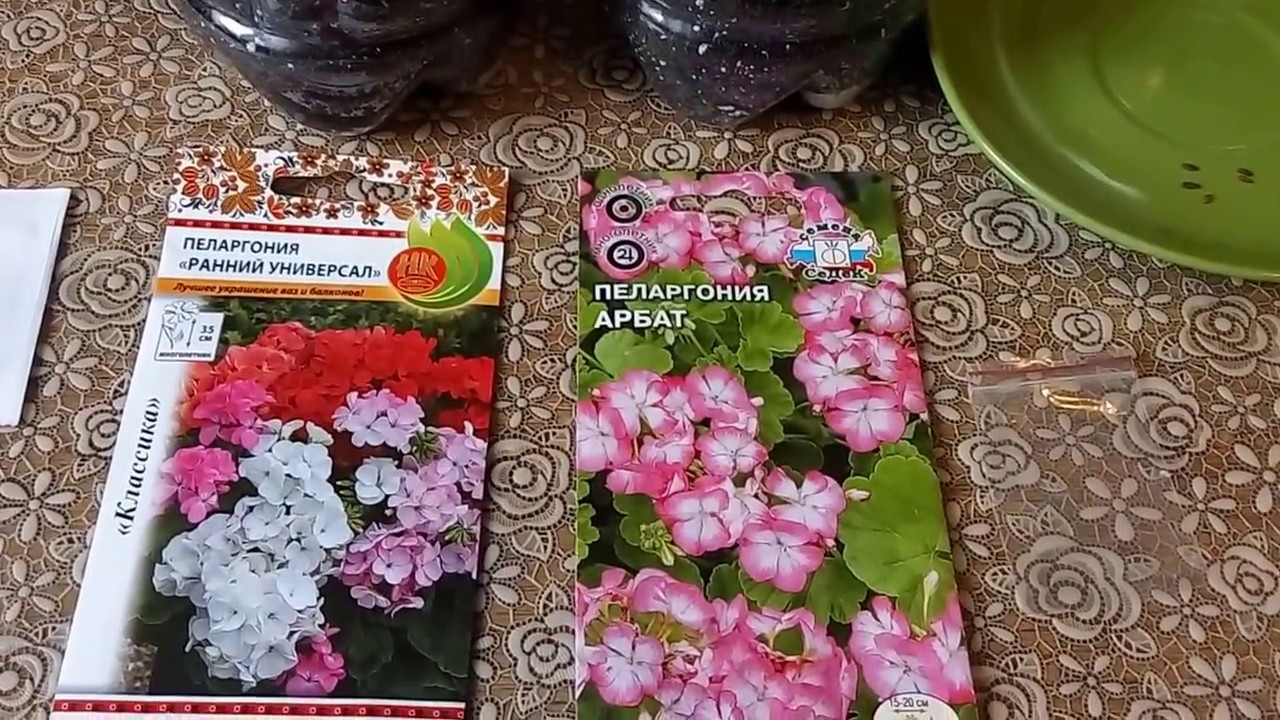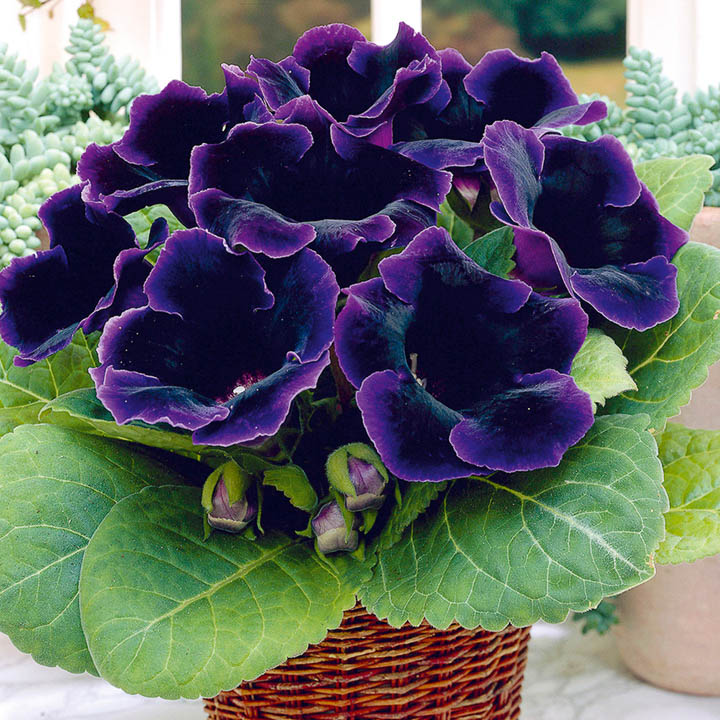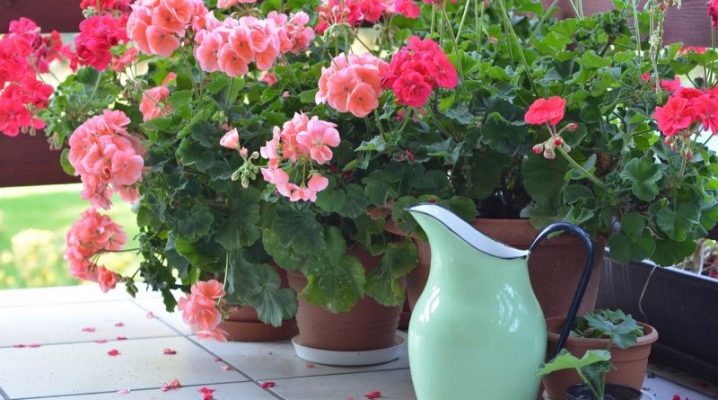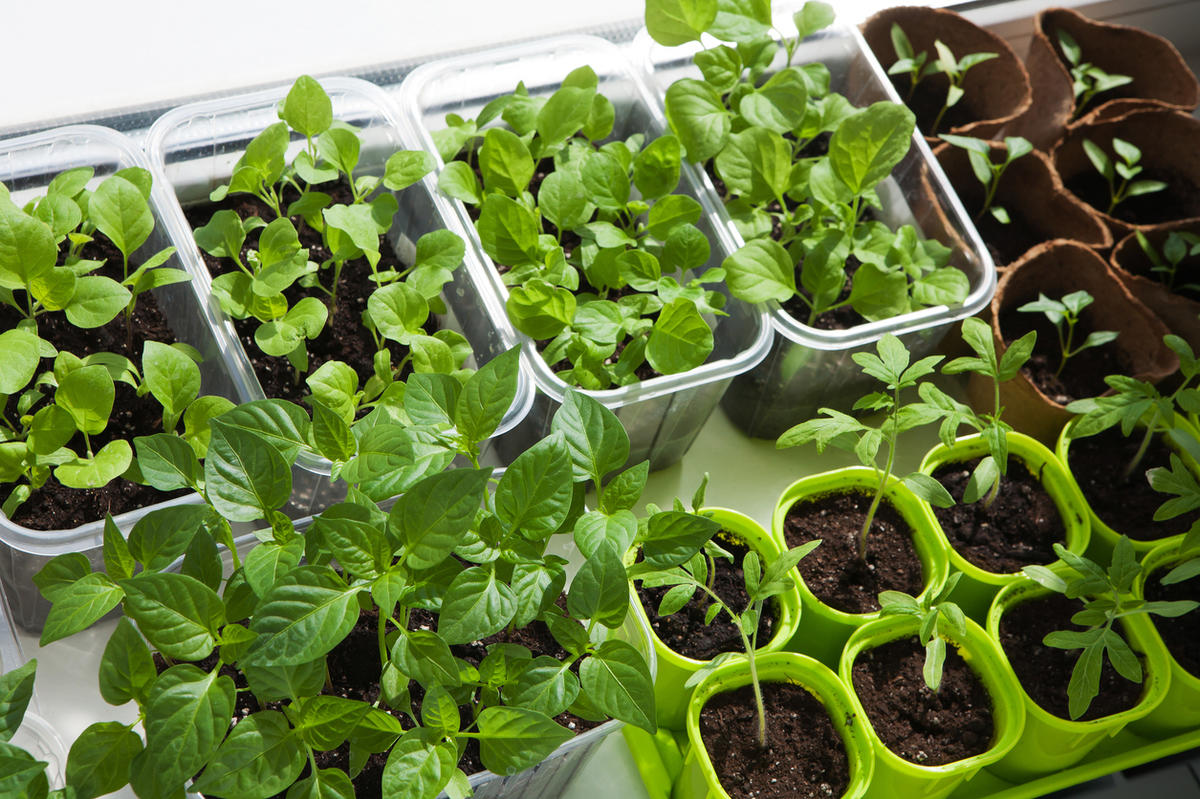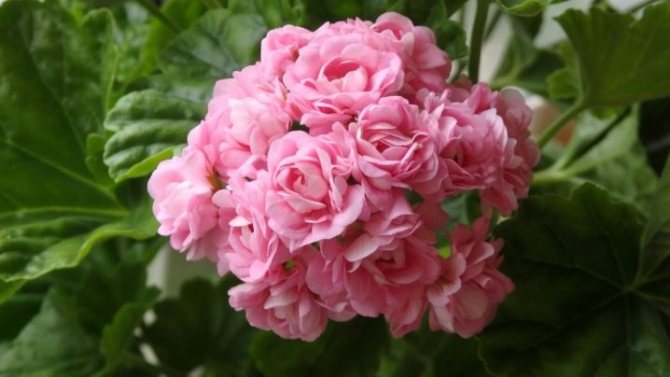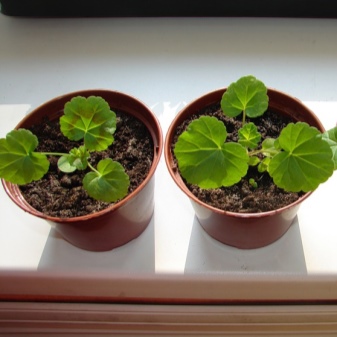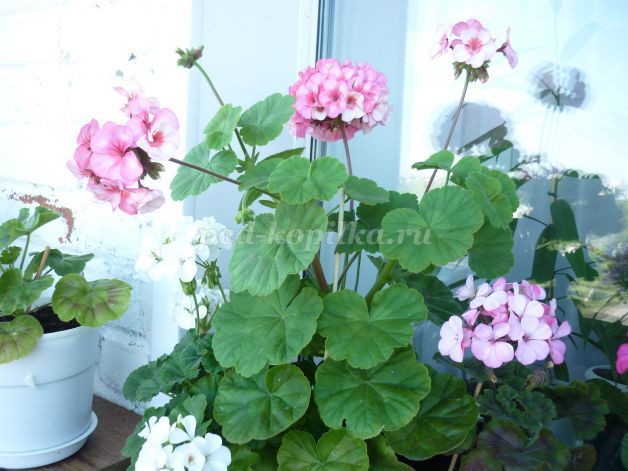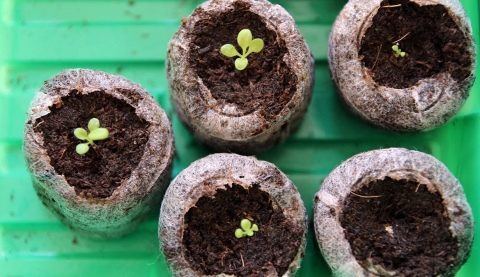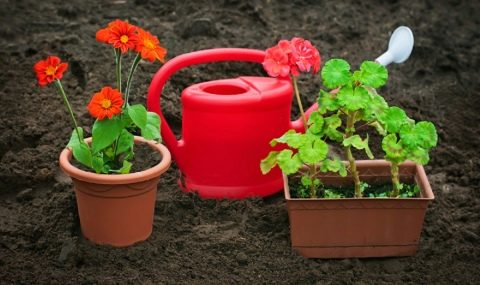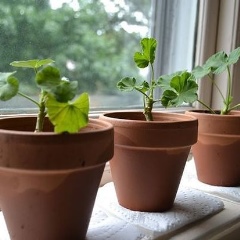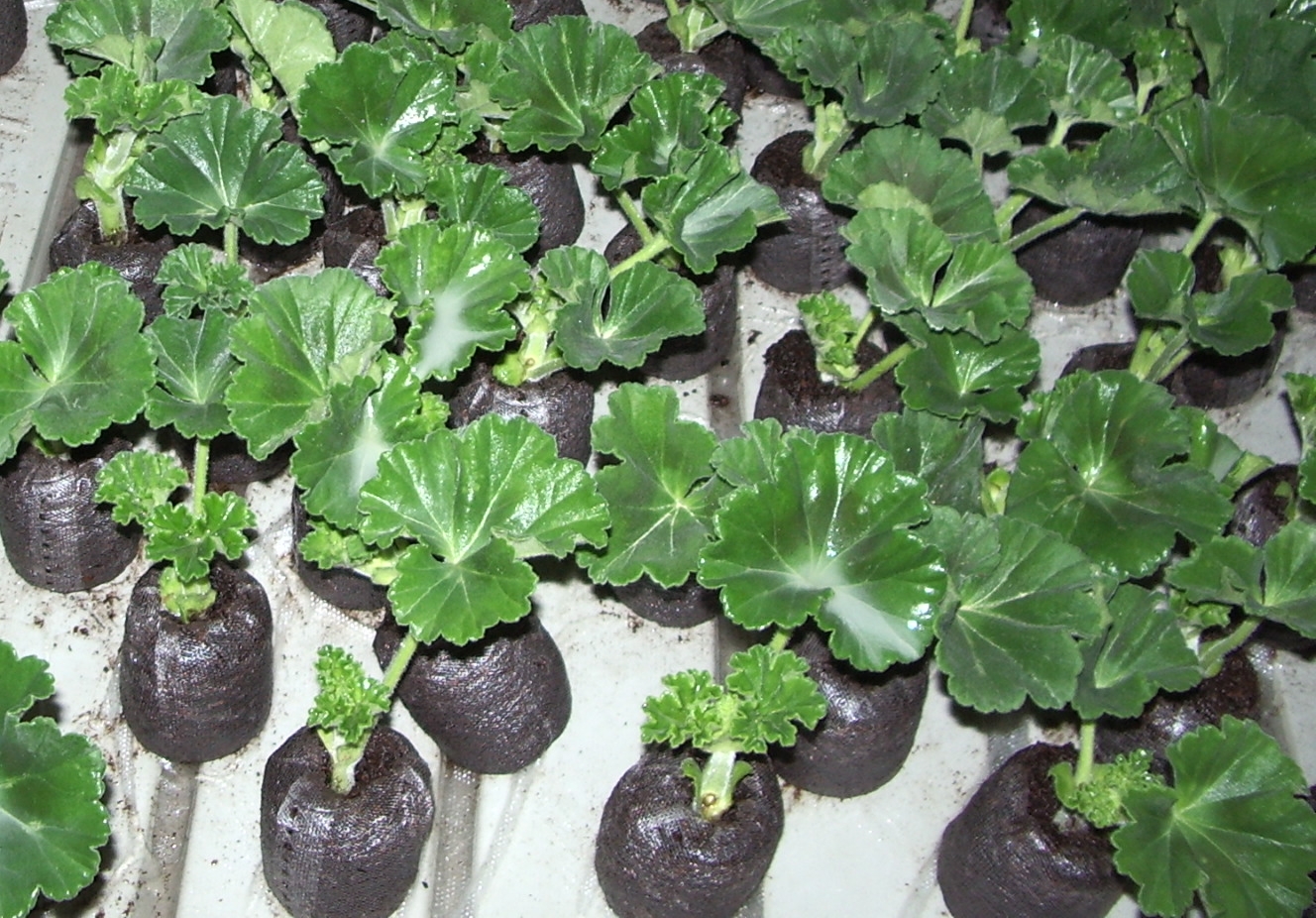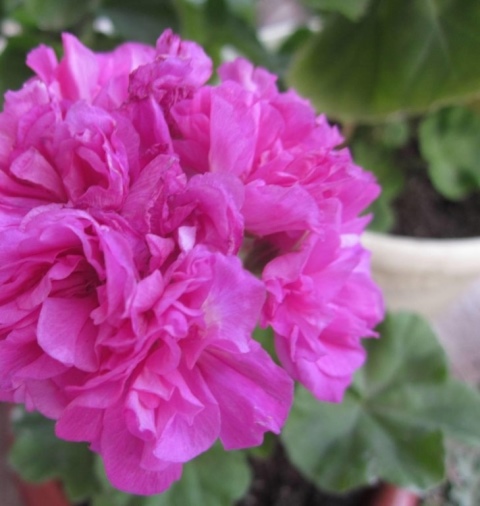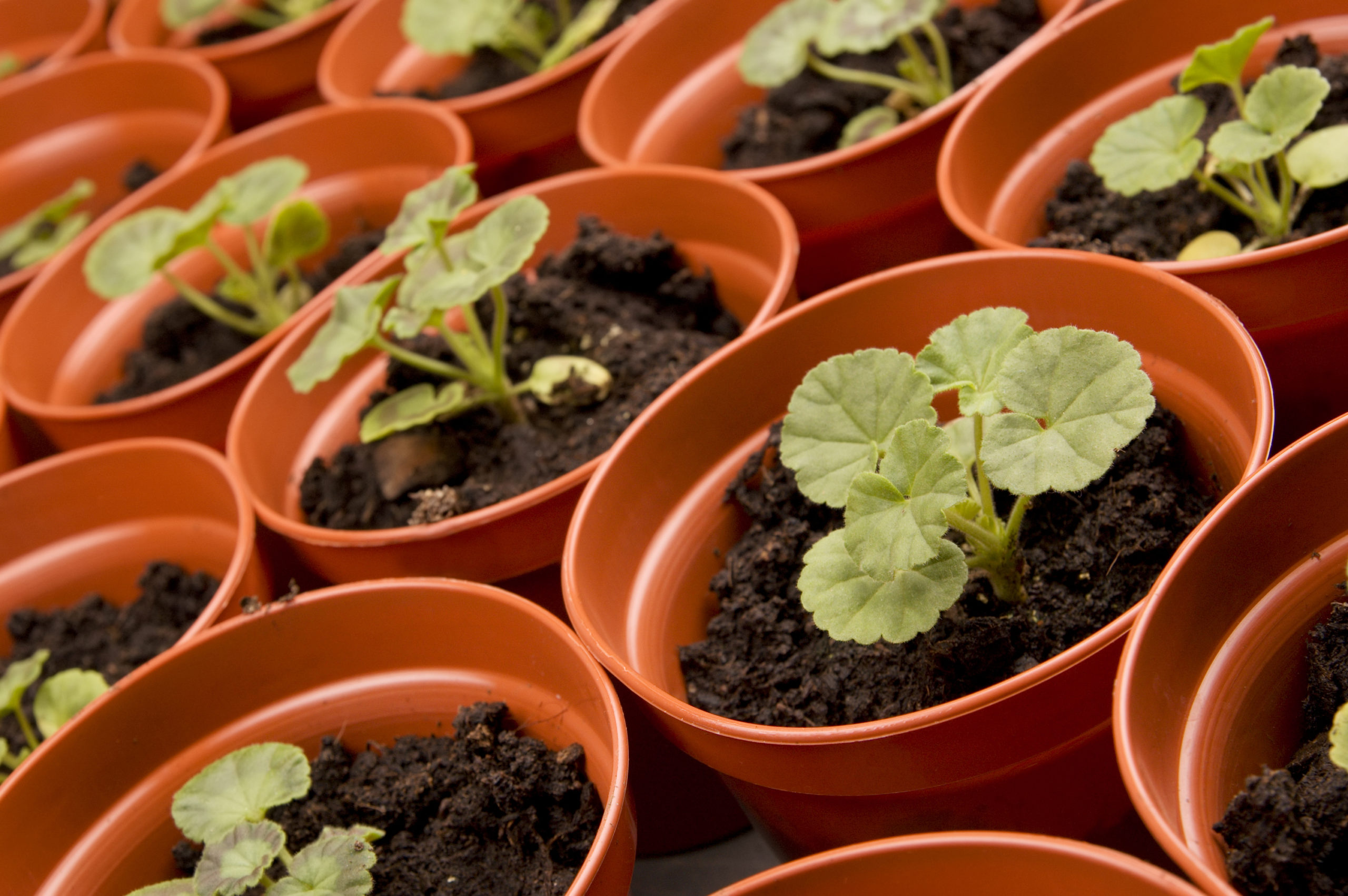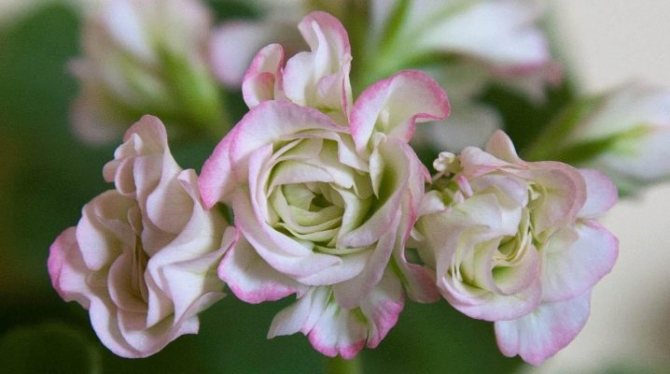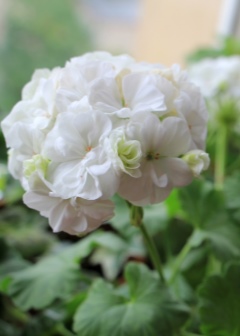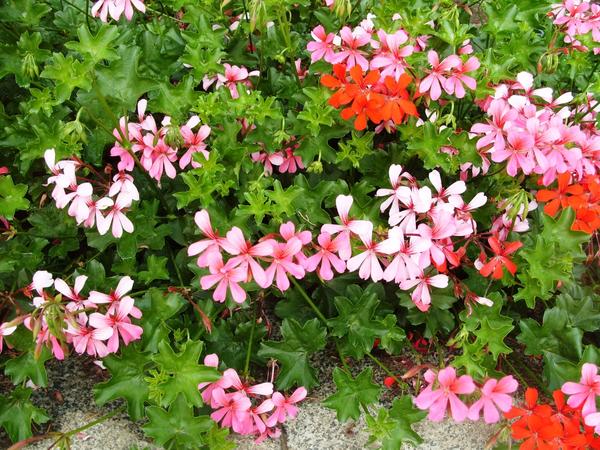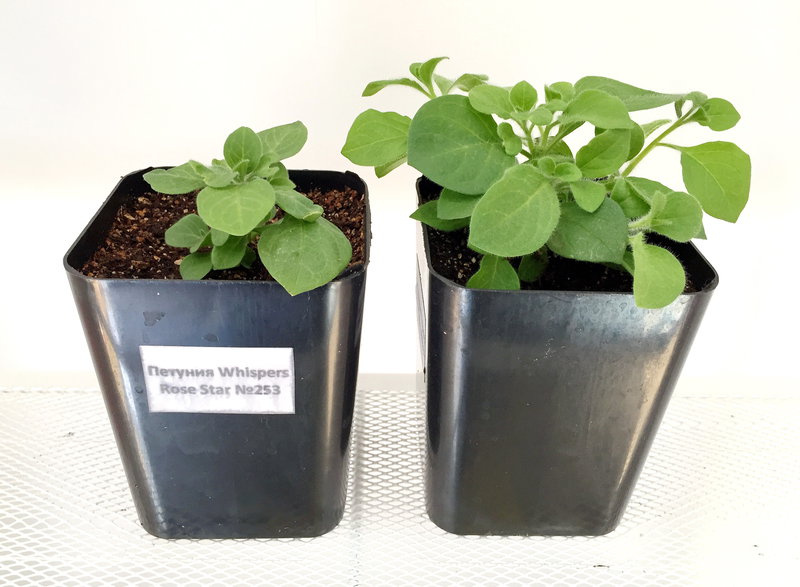When should you sow pelargonium seeds for seedlings?
Many people know that pelargonium propagates by cuttings, but now the seeds of the plant have appeared on sale. Therefore, propagating geraniums at home has become even easier.
The advantages of seeds are that they germinate quickly and well, the plant has a compact shape and constantly blooms. Young shoots of the plant bloom by 5 months.
What do pelargonium seeds look like and what should be done with them before planting in the ground?
The seeds of the plant are hard, large and have an oblong brown color. To plant seeds, you need to prepare the soil, it must be loose.
On this topic:
BACK
FORWARD
1 of 88
The composition of the land should be something like this: 2 parts of sod land and one part of sand and peat. So that the plant does not fatten, the substrate shouldn't be rich in nutrients.
Before planting, it is imperative to disinfect the soil (steam it, heat it or water it with a solution).
For sowing seeds, you need to prepare a shallow container. Spread the seeds over the surface at a distance of two centimeters from each other. Cover the seed with soil, about 1 centimeter. Be sure to keep the seed container warm. The soil should not dry out, so moisten it with warm, settled water.
On this topic:
BACK
FORWARD
1 of 45
Also, in order for the seedlings of pelargonium to sprout faster, you can cover it with a film, but be sure to make holes in it for airing. As soon as shoots appear, remove the film immediately. Seedlings should be kept in a well-lit place. The soil should be moderately moist, should not dry out and not flood. Avoid direct sunlight.
Pelargonium seedling care
It is a pleasure to grow pelargonium seedlings. This process is very interesting and exciting not only for an adult, but also for a child. Seedlings will appear in about a week. It is so pleasant to watch how velvet leaves emerge from each seed. Everything is fine, of course, but you need to transplant pelargonium seedlings into separate pots. Therefore, we do the following procedures:
- As soon as four leaves have appeared on the plant, then it is time to transplant them into a pot. You will need a container about 8 centimeters in diameter.
- The plant must be dived. This means that each plant must be transplanted from a common soil (container) into a pot.
- With the help of a small spatula, remove each plant with a small clod of earth in order not to damage or disturb the roots.
- Plant pelargonium in your pot.
- Potted soil should not be rich in nutrients. Therefore, if you use a commercial mixture, and it is mainly peat, it must be diluted with garden soil and compost.
- After planting, you can now observe the growth rate of the plant. If you adhere to all the rules, then geranium grows by leaps and bounds.
Now all that remains is to wait for flowering. Of course, many believe that a young plant will bloom in a year, do not believe the rumors. It will take about five months to wait for the flowers.
You can also face such a problem as yellowing of the leaves and the appearance of brown and yellow spots. This could be due to the heat. Therefore, many gardeners and flower growers plant geraniums in the garden. The result is surprising to many. Since the plant becomes even more beautiful, it blooms constantly, there are no yellow leaves. This method can be used to save your favorite flower during the hot season.
With proper care, the plant does not get sick and is not damaged by pests.Therefore, let this amazing and unpretentious flower delight you for many months.
When to plant petunias for seedlings - read here!
Dive seedlings
When the first true leaves appear, we begin to dive the seedlings. Do not delay this process too much, otherwise the root system of the seedlings will intertwine with each other and it will be more problematic to separate them from each other. For picking, select pots with a diameter of 10 cm and fill them with any of the previously proposed substrate options.
To stimulate the formation of lateral shoots and to suspend the growth of the plant upward, the geranium must be pinched over a 6–7 leaf. However, if you want a tall plant with strong stems, you can skip this point.
To grow geraniums from seeds, growing seedlings in a temporary container is not enough. Plants will need to be subsequently transplanted into a permanent pot. The signal that the flower is ready to "move" will be the appearance of 2-3 leaves in a new individual. Do not immediately transplant pelargonium into a large pot.
The transplanted plant is watered with a small amount of water. In warm weather, the transplanted flower is taken out to the balcony.
As you can see, the cultivation and care of pelargonium is not difficult at all. It is enough to surround the seedlings with care, and multi-colored hats will soon appear on the windowsill. If desired, in May, pelargonium can be planted in a flower bed, where it will delight with flowering all summer. Before the onset of frost, the flower is transplanted back into the pot and brought into the room.
When several leaves appear on seedlings on geranium sprouts, it must be dived, that is, planted. The seedlings are transplanted into small pots. When picking, it would not hurt to use clay pots, as this is the most correct solution, because they retain moisture much longer and protect plant roots from overheating.
If geranium is found outside, if the air temperature reaches below 10 ° C, it is necessary to cover it with a film or transfer it to the house. In hot weather, you need to water the geranium no more than once a day, and at medium temperatures, it needs to be watered once every couple of days. When watering, make sure that no water gets on the plant and its leaves. Geranium is afraid of drafts, so it is undesirable to spray the flower with open doors, as it can freeze and die. Twice a month, you need to feed the soil with any flower fertilizer that can be found in flower shops.
Faded inflorescences will need to be removed, but only for those varieties of geraniums that need it and if this variety does not discard them itself. You need to pinch the flower so that its stem does not stretch up. This can help form a small crown. This should be done only when the plant has reached a height of 10-12 cm.
At the moment, geranium is in great demand, as it has a number of advantages. The light-loving plant will appeal to many, since it has a bright color, and its splendor has a competitive ability over other plants. The specific smell of pelargonium may not please everyone, but knowing its useful properties, many change their attitude towards this flower. Those rooms in which pelargonium is located are endowed with their own positive energy. In such rooms, flies, mosquitoes and plant pests are practically not found.
Geranium is easy to care for. She needs constant watering, but in the absence of it for no more than three weeks, it will still feel great. With such a long break, it is desirable that the plant is not on the window, but in a place with high humidity. This is necessary in order to exclude the risk of burning the plant by direct sunlight.
For information on how to grow geraniums from seeds, see the next video.
The most popular varieties: top 10 with a photo
The Pelargonium genus includes about 250 species, but only some of them are used in indoor floriculture and landscape gardening. The variety of species and a huge number of interesting varieties allow you to choose the best option for garden design.
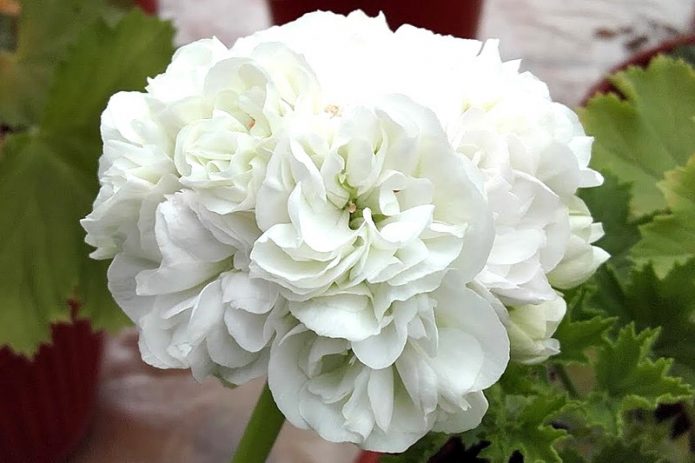
Due to its ivy-like leaves, Ice Rose is called ivy.
Pelargonium ivy Ice Rose has medium-sized dark green foliage. The compact plant produces very large white flowers that resemble roses.

Dissected purple-pink flowers of the Mons Ninon honeycomb with a white border around the edge prefer to grow on the sunny side
Fragrant Pelargonium Mons Ninon from the Unicum group is distinguished by strongly dissected and curly leaves that exude the scent of rose and lemon. The flowers are purple-orange-pink.
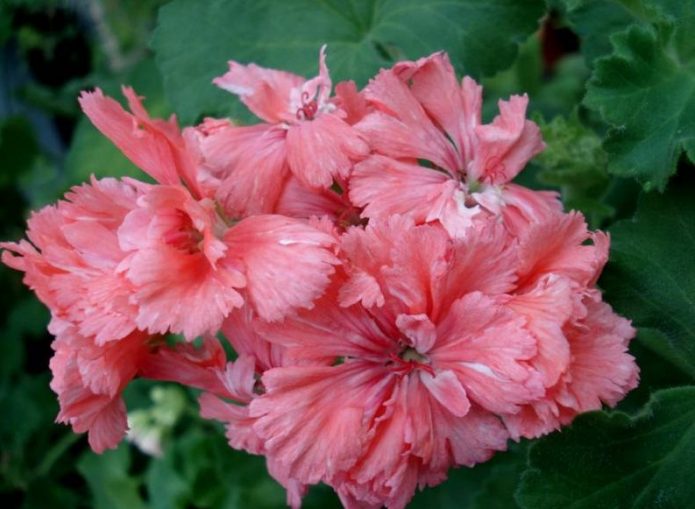
Coral pink flowers with scalloped petals in Diana Palmer show lush bloom
Diana Palmer clove geranium produces pinkish coral flowers with scalloped petal edges. Leaves are deep green in color, medium in size.

After a month and a half, a bush with semi-double pink-coral flowers grows from a Natalie cuttings
The dwarf variety of zonal pelargonium Natalie forms compact bushes and incredibly beautiful, semi-double and rather large peach-colored flowers with a delicate edging.
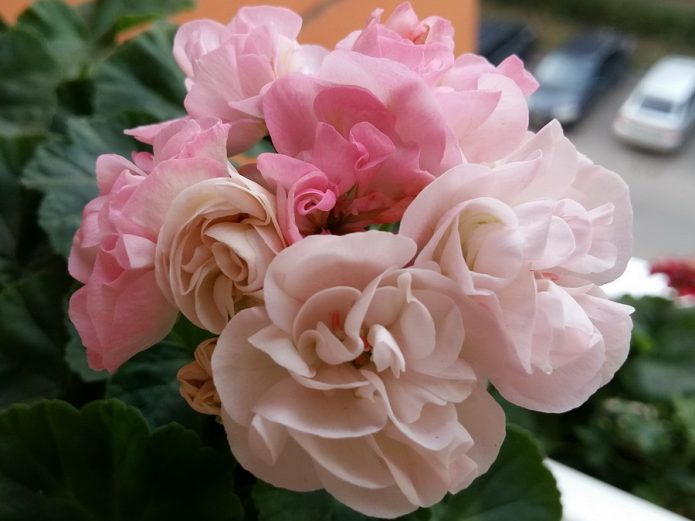
Dovepoint buds form very dense inflorescences with pale pink flowers
Zonal geranium terry Dovepoint is distinguished by large double, pale pink flowers with iridescence, collected in dense large inflorescences on thick and short peduncles.

The Rembrandt variety with large flowers of a plum-ink shade prefers wintering in the cool
Royal Pelargonium Rembrandt is characterized by large inky purple flowers with a large wave along the edges of the petals and a well-defined purple mesh.

Fringed Patricia Andrea with coral red tulip flowers is fast growing and forming
Pelargonium tulip Fringed Patricia Andrea forms shiny green leaves and flowers with coral-red petals, on which the veins are clearly visible.
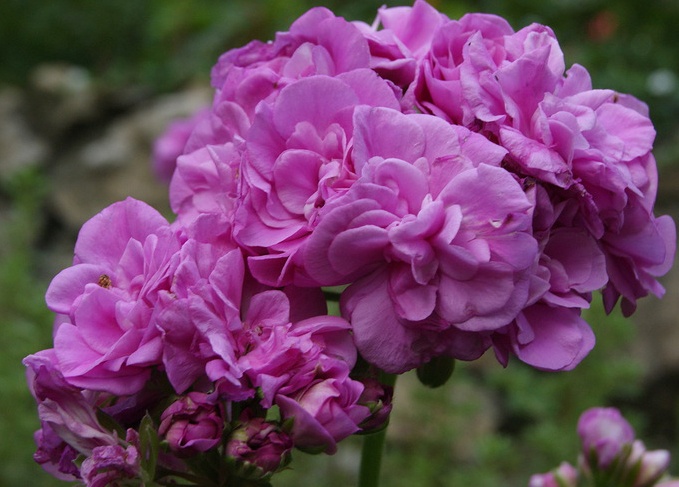
The Blue Spring cultivar is distinguished by large double flowers of lilac-pinkish coloration.
Eevee hybrid Blue Spring, obtained by crossing zonal and ivy-leaved Pelargonium, is suitable for growing both indoors and in balcony boxes and in a flower bed.
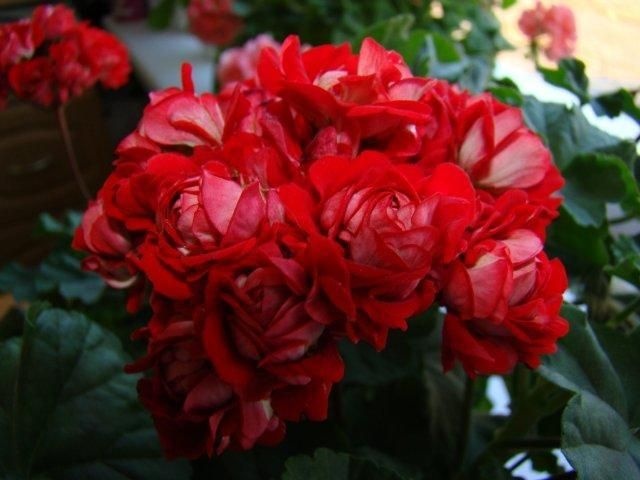
Vectis Rosebud with deep red roses is distinguished by long and lush flowering
The rosebud variety of pelargonium Vectis Rosebud is a spectacular densely doubled flower with compact and neat brushes, elegant dark green foliage and bright red-burgundy inflorescences.
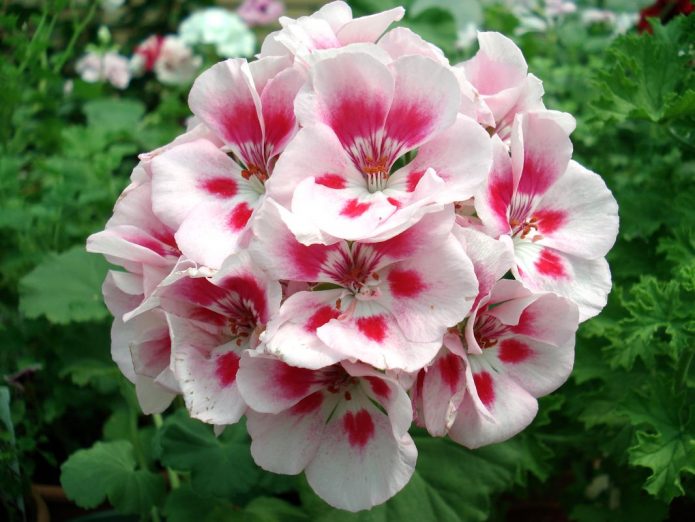
The Lieke variety, showing a spherical bush with large pale pink inflorescences, is popular in landscape design
Pelargonium Lieke from the Toscana zonal series is distinguished by very large inflorescences of pale pink color with a pinkish-red eye, forms a compact spherical bush.
Pelargonium seed and soil preparation
There are about 250 varieties of geraniums and before buying seeds you need to decide on your preferences: plant height, bush shape, color of leaves and flowers, purpose (decorative, medicinal). An important role in the choice of seed material is played by the place where the flower will grow: room, balcony, street.
The seeds offered in the store are classified into three types:
- scarified - the seeds are peeled from the shell;
- wrapped in nutrients and antifungal agents;
- are in a natural shell.
According to the observations of flower growers, seeds without a shell germinate better and get sick less. When buying non-scarified seeds, it is recommended to treat the shell with sandpaper with a fine abrasive and soak them in warm water with the addition of a growth regulator (Epin, Zircon).Pelargonium prefers loose, not heavy soil, which can be purchased at the store or prepared by yourself.
Geranium potting mix options:

Put the prepared soil mixture in a container for seedlings, compact it slightly, pour with a pale pink solution of manganese or infusion of garlic (100 g per 10 l) and stand for 2-3 days. After processing, sowing can be carried out in a day, after watering the ground with water at room temperature.
Reproduction of room geranium
Indoor white geranium
Before growing indoor geraniums, you should know a few important rules:
- the best place for a pot is a well-lit windowsill, since the plant loves sunlight very much;
- in winter, it is better to keep the flower in a cool room, but the temperature should not be lower than 10 ° C;
- in order to increase the number of shoots and inflorescences, the plant should be pinched, and dried flowers should be removed;
- almost all types of pelargonium must be trimmed regularly;
- with sufficient nutrition and light, the flower can bloom throughout the year.
Growing from seeds
Seeds - photo
Red, white, fragrant, as well as ampelous pelargonium grows best in indoor conditions. Before starting planting, you should make sure that the seeds are free of hard leathery shells. Otherwise, they will need to be well sanded with sandpaper. Experienced flower growers do not name the exact time for planting, since with sufficient lighting, seedlings can grow in autumn and winter, but the period from November to April is considered the optimal time.
The surface of the seeds must be scratched with a knife or rubbed with an emery stone
Before sowing, the seeds should be prepared in a certain way: treated with zircon or epinin, and soaked for three hours, no more, in water at room temperature.
Take containers or boxes that are filled with a mixture of turf with sand and peat (2: 1: 1) or a peat-perlite mixture (1: 1) - this is the substrate that is best suited for growing seedlings.
Spread the seeds at a distance of at least five centimeters, sprinkle a little and cover with plastic or glass. Spray the soil constantly from a spray bottle with pre-settled water at room temperature and make sure that it does not dry out.
If the temperature and humidity conditions are correct, the sprouts will appear in two weeks.
The transplant is carried out when 2-4 sprouts appear on the seedlings
It is very important not to miss this moment, as the roots will intertwine and it will be very difficult to transplant. The pots must be at least 10 cm long.
Room geranium care
Despite the fact that geranium loves moisture, it should not be in stagnant water, so a layer of expanded clay should be poured onto the bottom of the pot. Water the plants with a narrow-nosed watering can. As soon as 6-7 leaves appear on the plant, it must be pinned to stop its growth and "awaken" the lateral buds. On cloudy days, Pelargonium must be provided with additional lighting. In summer, it is better to take it outside and put it in a place protected from direct exposure to ultraviolet rays (the plant loves warm, dry air).
How to care for room geraniums
You need to fertilize the flower once every two weeks, starting from the end of March and until November, using liquid fertilizers for this. In addition, you can prepare top dressing yourself: for this, a liter of water is taken, to which a drop of iodine is added. You need to take 50 ml of this solution, and gently water the plant with it so that the liquid does not fall on the roots, but on the walls of the pot. Geranium does not need spraying.
Geranium care
Pelargonium is susceptible to a number of diseases, therefore, the plants should be regularly examined for the appearance of characteristic signs. These can be yellowed leaves, reddened leaves, gray mold, or leaf fall.Usually the reason for such phenomena is too low room temperature or excess moisture. The most dangerous disease for geraniums (especially for young shoots) is called "black leg". In this case, the base of the stem begins to darken in the plant - unfortunately, there are no radical methods of combating this phenomenon, so the infected specimens will have to be destroyed.
Geranium diseases
Choosing the "right" pot
Small compact pots or trays 3 cm deep are suitable for germinating pelargonium. You can buy containers in special stores or make yourself.
For cultivation, boxes or pots are used. The pot in which the flower will be located is selected according to the size of the root system. The transplant is carried out only when the plant becomes cramped (you can learn more about how to transplant and root pelargonium here). It is advisable to use clay pots. They are highly breathable and absorb moisture. You can use plastic pots, but they do not allow air to pass through and can lead to stagnation of excess water. This can lead to root rot and plant disease.
If it is possible to prepare a growing substrate on your own, then it should be used. In the purchased soil, seedlings appear later, the seedlings are weaker, the bush forms thin or unnecessarily thick stems, the flowering of the plant is scarce.
Seedling care
It is very important to monitor the correct watering of the seedlings after the pick. At first, they are watered with very small doses of water, the soil was moderately moist, but not wet
Watering is carried out at the root with settled water with a temperature not lower than +18 .. + 20 ° С. Do not allow moisture to enter the leaves.
If moisture gets on the leaves, a disease such as black leg may develop. If signs of fungus appear, Fitosporin solution or other biological products are injected into the ground in compliance with the rules of the instruction. From the phase of mass shoots, the air temperature is reduced by 2-3 ° C. In the future, it is set at +18 .. + 20 ° C.
For feeding seedlings, you can use a commercially available composition with trace elements. Fertilizer is introduced into the soil 2 times a month. In order not to damage the young shoots of pelargonium, the dose of the agent recommended by the manufacturer for nourishing the flowers is diluted 2-3 times.
When the plant reaches a height of about 8-10 cm, it can be transplanted to a permanent place in a spacious pot. To preserve the integrity of the root system, geraniums are transplanted using the transshipment method. The flower is placed on windowsills, where sunlight illuminates the plants from morning until 11 o'clock or after 15 o'clock in the afternoon. In this case, direct sunlight will not damage the plant.
Geranium will look beautiful if properly cared for. Bushes require regular watering, timely fertilization, cutting off dry leaves and inflorescences
It is important to pinch the plant so that it does not grow in height, but has a beautiful crown shape
Geranium is pinched when it reaches a height of 10 cm. It is recommended to turn the container with a flower with the other side towards sunlight once every 5-6 days. In this case, the main stem will not bend.
Growing flowers from seedlings at home
The homeland of this beautiful and bright flower is the territory of India and South Africa, therefore, the plant needs a sufficient amount of warmth and light for full growth and development, as well as abundant flowering.
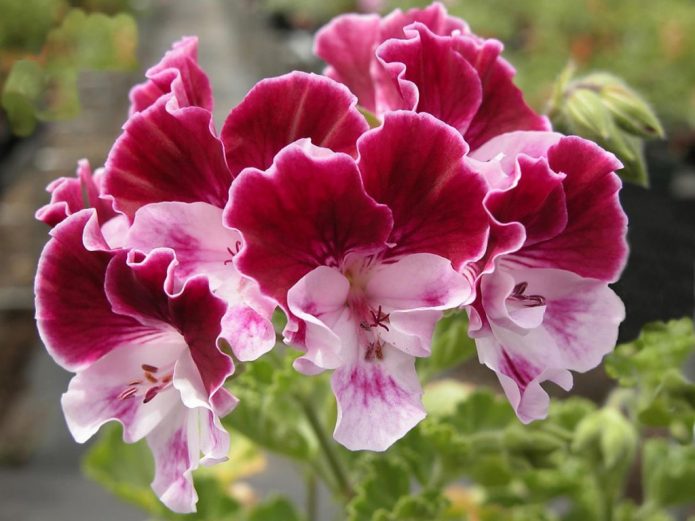
Geranium shows large and beautiful flowers from a five-leaf open cup
It is recommended to grow this herbaceous or semi-shrub decorative perennial in climatically unfavorable regions only in indoor conditions or in the traditional seedling method with the aim of further landscaping the local area. Direct seeding into the ground will not be successful.
Feeding pelargonium
For abundant flowering, you need to periodically replenish the amount of nutrients in the soil. This requires one-component fertilizers with potassium, nitrogen, phosphorus, iodine, complex fertilizers developed specifically for geraniums.
When and how to feed geraniums:

Important!
Apply all fertilizers strictly according to the instructions. For abundant and long flowering of geraniums indoors and outdoors, a home remedy is used - iodine solution
For abundant and long flowering of geraniums indoors and outdoors, a home remedy is used - iodine solution.
How to feed with iodine:
- Moisten the soil in the pot well. 2. Prepare a solution of 1 drop of iodine and a liter of water. Good results are obtained by adding 1 ml of hydrogen peroxide. The dosage should be strictly observed - iodine in large quantities can damage the roots. 3. Carry out watering, moistening the soil with the solution along the edges of the pot, being careful not to get on the leaves. Solution consumption - 50 ml for one watering. 4. Feed from May to September once every three weeks.
How to sow pelargonium seeds correctly
In order for the growth and development of pelargonium seedlings to go in the right direction, it is necessary to choose the appropriate container, suitable soil and properly prepare the seeds for planting.
The choice of planting capacity
The planting container is selected based on your capabilities and needs, as well as the number of seeds for future seedlings.
If you plan to carry out a pick, then you can sow in common containers, for example, in the same plastic containers (5-6 cm high).
If it is more convenient for you to grow without picking, then pelargonium seeds can be sown immediately into individual and relatively deep containers, for example, pots or cups (8-10 cm high). Naturally, they should have drainage holes to drain excess liquid so that the water does not stagnate.
If you want pelargonium to bloom in your pot, then it must be at least 1 liter in volume.
Suitable soil
The soil for growing pelargonium seedlings should be loose and nutritious, as well as neutral in acidity. Therefore, any universal soil for growing flowers is perfect for you, but in general, it is ideal to take a special soil for geraniums.
It is very good if you prepare your own substrate, which will consist of turf, peat and sand in a 2: 1: 1 ratio. You can use perlite or vermiculite instead of sand.
Seed preparation
Many growers quite successfully sow their seeds without any treatments, just dry in wet soil. But, in order to increase germination, they should be scarified or soaked.
Pelargonium seeds can be scarified with sandpaper, in other words, slightly damage the shell so that the sprouts can easily be nailed down. However, this must be done very carefully, otherwise you will easily spoil your seeds.
Or you can simply soak it in cotton pads in a phytosporin solution (some soak in a 3% hydrogen peroxide solution) for 20-30 minutes, moreover, it will also disinfect them.
Direct sowing
Step-by-step instructions for sowing geranium seeds for seedlings:
- Fill containers with soil.
- Make grooves (3-4 cm apart) or shallow holes (0.5-1 cm).
- Moisten the soil with a spray bottle.
- Spread the seeds 2-3 centimeters apart.
- Moisten with water from a spray bottle.
- In order for the seeds to begin to actively germinate, you need to create greenhouse conditions, in other words, to achieve a greenhouse effect, which means that you should cover the container with cling film or a transparent lid (if you have a food container).
- Put in a dark and warm place (above +20 degrees, according to some sources - + 24-28 degrees).
Video: correct sowing of geraniums for seedlings
Video: sowing pelargonium in boiling water
Video: sowing pelargonium in peat tablets
Growing by seeds - suitable varieties
There are many varieties of the described plant. There are perennials, annuals, shrubs, succulents.Most Popular:
- zonal;
- ivy;
- fragrant;
- large-flowered:
- angels;
- unique;
- interspecific hybrids;
- species.
Zonal got its name from the rings on the leaves. It is unpretentious, long and richly blooms of various colors with fragrant or completely odorless flowers (from white to red). In height, the bushes can reach several meters in the open field and about a meter at home. Ivy-leaved - the leaves are like ivy, without the edge, the stems creep, growing into a kind of carpet. Looks attractive in hanging pots. Fragrant - exudes a smell when you touch the leaves, which are cut with deep depressions. The inflorescences are unsightly. The height of lush shrubs is more than a meter. Large-flowered - no ball-shaped inflorescences, grows in a bush. Flowers can be up to 8 cm in diameter. Angels are famous for their pansy-like flowers. Unicums delight with inflorescences of a small number of beautiful flowers similar to angels or large-flowered pelargonium.
Attention!
When growing from seeds, it is important to keep in mind that they will produce plants with the usual five-petalled flowers. Complex terry, rosaceous or tulip-like varieties can only be obtained by propagation by cuttings
When flowering, a seed-grown plant can shed its petals abundantly. But these are small drawbacks compared to how long and unpretentious beautiful flowers please the eye.
Propagation by cuttings
This method is perhaps the easiest, short-term and most effective one. And also allows you to preserve all the varietal properties of the mother plant.
The key to a successful operation lies in the observance of two conditions - maintaining the optimal temperature and constant lighting.
The advantage of this method is that grafting can be done several times a year. However, it should be borne in mind that in certain months the plant is at rest (November-January), and therefore it will not work to grow a strong plant from cuttings. And if you want pelargonium to bloom already this year, then you need to start propagating it already in March, since it is during this period that all the vital forces of the plant are activated, active juice begins. And planted geraniums in April will bear flowers only next year.
Pelargonium can also be propagated by cuttings in the fall (September-October) during routine pruning after flowering. These cuttings will rise well during the autumn-winter period and will give the first color the next summer.
Cutting technique:
Apical shoots, which have 3-4 leaves, are suitable for reproduction. The length of the cutting should be approximately 7 centimeters.
Please note: if a bud or bud remains on the cutting, then such an shoot will not give roots for a long time. Therefore, all flowers and buds must be removed.
- Cuttings are cut only with a sterile instrument, and the entire operation is performed with gloves so as not to inadvertently infect the slices.
- The taken material is removed for several hours in a shaded place so that the cut is covered with film.
- So that the cut does not start to rot, it is sprinkled with coal or "Kornevin".
- The cuttings are dipped in water and await the formation of roots. Then the shoot is planted in the ground.
- You can avoid overexposure in water and plant the cutting directly into the ground. The soil must be moistened and disinfected in advance.
- Containers with shoots are covered with a lid or other protective material, creating a greenhouse effect. In some cases, this is not required, for example, if the cuttings are strong and healthy.
Plants are provided with comfortable conditions - the temperature in the room should be + 22-23 degrees, the humidity of the air - 80%.
Pelargonium, propagated by cuttings, grows very quickly with roots, there is practically no waste.
Home care for pelargonium from seeds
Pelargonium does not need to create any special conditions for further growth and development, but still requires some care.
- Lighting.Adequate lighting ensures good development of geraniums. With a lack of light, the leaves of the plant fall off, the flowers become faded and can also crumble. At the same time, direct sunlight does not pose any threat.
- Watering. In winter, watering of the plant should be limited, in summer, it should be made more abundant. But you cannot spray the leaves, as well as fill the roots - this can lead to their decay and the death of pelargonium. If you notice that the leaves of the plant have become thin and yellow or brown spots have appeared on them, this is also a sign of over-watering.
- Content temperature. The optimum temperature for normal growth and development of geraniums is 18–20 ° C. In winter - not lower than 10-15 ° C.
- Top dressing. Although pelargonium does not need feeding, all-purpose fertilizers can be used to meet its needs. The regularity of top dressing is every 2-4 weeks.
- Transfer. If the plant becomes cramped in the pot, it must be transplanted into a more spacious container. This is best done in the spring.
- Priming. Drainage plays an important role in ensuring the correct growth of pelargonium from seeds. To do this, with each transplant, a layer of expanded clay must be laid on the bottom of the tank.
Compliance with the basic rules of caring for the plant guarantees its protection from pests and various diseases. In the case of excessive moisture in the substrate, there is a high probability that geranium will be affected by fungal diseases.
In addition, too hot and dry air can provoke the appearance of a whitefly. In these cases, special drugs are used to eliminate the problem.
By following these simple recommendations, you can easily grow pelargonium from seeds on your windowsill. And then a beautiful and at the same time unpretentious flower will delight you for many years.

